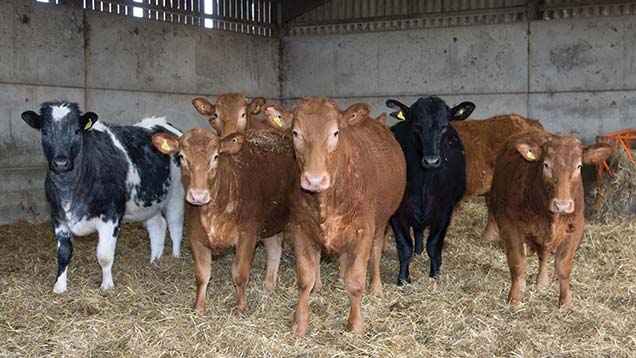How to reduce beef feed costs with high youngstock growth rates

Pushing for high youngstock growth rates in the early part of winter will reduce beef farmers’ overall feed costs.
Growing animals should be achieving a minimum daily liveweight gain (DLWG) of 0.75kg/day, with many breeds and cross-breeds hitting 0.9kg/day.
That is according to Pete Kelly, ruminant nutritionist from Kelly Farm Consulting, who believes store periods are inefficient.
“In terms of getting feed efficient animals and growth, we need to be looking at fairly high growth rates throughout the growing period,” he said.
See also: Cow rears eight calves in four-and-a-half years
A 300kg animal growing at 0.3kg/day will use 82% of its energy on maintenance, leaving just 18% for growth, compared with 55% on maintenance and 45% on growth if it is growing at 0.9kg/day, Mr Kelly explained.
But he said the target growth rate will vary depending on the breed.
“Early maturing breeds will get too fat if pushed at 0.9kg/day, but some fast growing breeds can cope with this throughout the growing period quite happily.”
Mr Kelly advised participants of the latest Eblex teleconference, to assess the target DLWG they’re looking for so the animals are at the right stage to finish or turnout at the end of winter.
However, he also warned farmers not to push youngstock too hard at the end of winter.
“When you turn out animals that have been done too well during winter they just stand still. Growth rates are poor and they lose the fat cover they went out with.
“You could’ve invested a lot of concentrates and feed in these animals with no real gain for a month after turnout.”
Once weaned at 7-8 weeks, concentrates should be fed ad-lib until young animals are consuming 3kg/day. This will give growth rates of at least 1kg/day and this can continue until they reach about 200kg or six months old, said Mr Kelly.
“It will cost more, but at the other end of the scale, if we get a very fast growth rate on young animals, we can finish them at 18 months old, rather than 24 months old.
“Total food used by the animals over their lifetime is less and concentrate use is lower because less is needed for the finishing period,” he added.
However, Simon Marsh, Harper Adams senior beef lecturer said he would expect to see a maximum of 0.8kg/day DLWG through the winter. Pushing youngstock hard at this time will require extra concentrates and is certainly not be best option for those with good grassland management, he added.
“Many beef farmers have a lack of focus on grassland management, but this is essential to achieve good compensatory growth at turnout, saving on the cost of additional winter concentrates.”
Mr Marsh explained how recent research at Teagasc has shown the extent of the cost savings.
A group of 250kg continental breed cattle fed silage plus 3kg a head a day of concentrates over winter put on 0.86kg/day, but only 0.71kg at grass.
Another cattle group of the same size and breed, fed silage and 1.5kg concentrates, put on only 0.66kg indoors but this rose to 0.83kg at turnout. There was little difference in overall performance, as the cattle fed to on the lower winter DLWG ration achieved similar DLWGs by utilising compensatory growth, he said.
“Feeding 1.5kg a day less over a 150-day housing period could also save £45 a head,” he added. [Based on a concentrate cost of £200/t.]
Mr Marsh’s top tip for feeding concentrates if you’re feeding an average of 1.5kg a head a day over winter, is to feed 2.5kg during the early part of the winter to capatalise on the younger animals faster growth rate, but crucially, cut this down to just 0.5kg in the latter part.
“Reducing concentrates in late winter allows the rumen to fully acclimatise for forage prior to turnout.”
Pete Kelly’s silage warning
Many silage analyses have shown poorer quality than last year and as a general rule, the beef industry is not making very good quality silage, said Mr Kelly, who believes farmers should be aiming for 11ME.
“The typical average is 10ME, and it all comes down to the cutting date, not really the type of grass grown.”
And there is a significant additional cost if silage quality is poor, he said.
A 200kg animal can get away with 1kg of supplement if the silage is 11ME and when they hit 300kg bodyweight, will require no supplementation at all while maintaining a similar growth rate.
Whereas a 200kg animal fed 10ME silage will need 2-3kg of concentrates to get anywhere near the 0.9kg/day LWG.
Mr Kelly also said presentation of silage was key as youngstock are often given big bale silage. They will find it very difficult to pull it out of the bale if fed whole in a ring feeder as they have weak teeth.
He advised farmers to chop bales in half before feeding, and next year, consider a chopper and baler to cut the forage to 10cm lengths.
